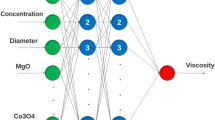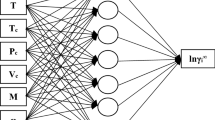Abstract
Artificial neural networks (ANN) and the concept of mass connectivity index are used to correlate and predict the viscosity of ionic liquids. Different topologies of a multilayer feed forward artificial neural network were studied and the optimum architecture was determined. Viscosity data at several temperatures taken from the literature for 58 ionic liquids with 327 data points were used for training the network. To discriminate among the different substances, the molecular mass of the anion and of the cation, the mass connectivity index and the density at 298 K were considered as the independent variables. The capabilities of the designed network were tested by predicting viscosities for situations not considered during the training process (31 viscosity data for 26 ionic liquids). The results demonstrate that the chosen network and the variables considered allow estimating the viscosity of ionic liquids with acceptable accuracy for engineering calculations. The program codes and the necessary input files to calculate the viscosity for other ionic liquids are provided.
Similar content being viewed by others
References
K. N. Marsh, A. Deev, A. C. T. Wu, E. Tran and A. Klamt, Korean J. Chem. Eng., 19(3) 357 (2002).
P. Wasserscheid and T. Welton, Ionic liquids in synthesis, 2nd Ed., Wiley-VCH Verlag GmbH & Co., Germany (2008).
M. Koel, Ionic liquids in chemical analysis, CRC Press Boca Raton, Florida, USA (2009).
R. L. Gardas and J. A. P. Coutinho, Fluid Phase Equil., 266,1–2 195 (2008).
D. Zhao, Z. Fei, R. Scopelliti and P. Dyson, Inorg. Chem., 43, 2197 (2004).
A. Ouadi, B. Gadenne, P. Hesemann, J. J. E. Moreau, I. Billard, C. Gaillard, S. Mekki and G. Moutiers, Chem. Eur. J., 12, 3074 (2006).
R. C. Reid, J. M. Prausnitz and B. E. Poling, The properties of gases and liquids, McGraw Hill, New York (1987).
NIST, IUPAC Ionic Liquids Database-(ILThermo), NIST Standard Reference Database #147, http://ilthermo.boulder.nist.gov/ILThermo/mainmenu.uix, access January (2009).
S. Zhang, X. Lu, Q. Zhou, X. Li, X. Zhang and S. Li, Ionic liquids, physicochemical properties, 1st Ed., 478 pages, Elsevier, Amsterdam, The Netherlands (2009).
N. K. Bose and P. Liang, Neural networks fundamentals with graphs, algorithms, and applications, in electrical and computer engineering, McGraw-Hill Series, McGraw-Hill Companies, Inc., USA (1996).
D.M. Himmelblau, Korean J. Chem. Eng., 17(4), 373 (2000).
J. Taskinen and J. Yliruusi, Adv. Drug Delivery Rev., 55, 1163 (2003).
T. Suzuki, R. U. Ebert and G. Schüürmann, J. Chem. Inf. Comput. Sci., 41(3), 776 (2001).
K. Konno, D. Kamei, T. Yokosuka, S. Takami, M. Kubo and A. Miyamoto, Tribology International, 36(4–6) 455 (2003).
A. Murata, K. Tochigi and H. Yamamoto, Mol. Simulation, 30(7), 451 (2004).
G. Padmavathi, M. G. Mandan, S. P. Mitra and K. K. Chaudhuri, Comput. Chem. Eng., 29, 1677 (2005).
G. Carrera and J. Aires-de-Sousa, Green. Chem., 7, 20 (2005).
J. O. Valderrama and P. A. Robles, Ind. Eng. Chem. Res., 46, 1338 (2007).
J. O. Valderrama and R. E Rojas, Ind. Eng. Chem. Res., 48, 6890 (2009).
S. Bretsznajder, Prediction of Transport and other Physical Properties of Fluids, 1st English Edition, Pergamon Press, Oxford, UK (1971).
J. O. Valderrama and R. E. Rojas, Fluid Phase Equil., 297, 107 (2010).
J.O. Valderrama, A. Reategui and R. E. Rojas, Ind. Eng. Chem. Res., 48, 3254 (2009).
Author information
Authors and Affiliations
Corresponding author
Rights and permissions
About this article
Cite this article
Valderrama, J.O., Muñoz, J.M. & Rojas, R.E. Viscosity of ionic liquids using the concept of mass connectivity and artificial neural networks. Korean J. Chem. Eng. 28, 1451–1457 (2011). https://doi.org/10.1007/s11814-010-0512-0
Received:
Accepted:
Published:
Issue Date:
DOI: https://doi.org/10.1007/s11814-010-0512-0




